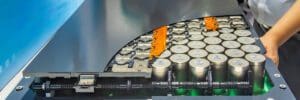One of the beloved bugaboos bruited by EV boo-birds is that EV batteries will quickly wear out. Now that there are significant numbers of high-mileage EVs on the road, this deceitful dirge has been definitively debunked. Car and Driver (among many other sources) estimates that a typical EV battery should last between 10 and 20 years (the average new car in the US is expected to last 12.5 years). A recent study by scientists at the SLAC-Stanford Battery Center found that most EV batteries are likely to last even longer than researchers had previously forecast. Real-world accounts of long-serving batteries, for example in Tesla taxis, abound.
Scientific studies and individual anecdotes give us two perspectives on battery longevity—a standardized test that measures the health of an individual EV’s battery gives us yet another. German testing organization DEKRA has developed just such a test, and has now completed more than 25,000 state-of-health tests using its patented procedure. Based on the data collected, DEKRA reports (via Electrive) that “the batteries of electric cars are more durable than consumers sometimes fear.”
DEKRA’s rapid battery test, which was introduced in 2022, is currently available for around 130 different vehicle models and is offered in several European countries. The procedure takes 15 minutes, and includes a static test and a short acceleration drive of around 50 to 100 meters.
The real-world results of an individual test are compared to the “parameterization” of the individual vehicle models, which includes data gathered from complex test drives under a wide variety of conditions. “This creates a kind of coordinate structure that our system uses to analyze and evaluate the actual measured values during the test,” explains Christoph Nolte, Executive Vice President of DEKRA. “The bottom line is a statement on the battery condition that no other method on the market can offer as quickly and at the same time as precisely.”
The growing data pool enables the DEKRA experts to make more general statements about battery aging, and they say that “even with higher mileages, the vast majority of traction batteries are still in good condition.” As one example, DEKRA cites a fleet of Jaguar I-Pace electric taxis that went into service in Munich in 2018. DEKRA tested six of the vehicles in 2024, and found that, with mileages between 180,000 and 260,000 kilometers, the state of health of the traction batteries was between 95 and 97 percent.
“On average, we charged the vehicles about one and a half times a day, and not particularly gently, but always fully charged to give the drivers the appropriate level of safety in terms of range,” said Gregor Beiner, Managing Director of the Munich Taxi Centre (MTZ). “The batteries are very, very durable and, especially with the safety buffers that the manufacturers install, they retain their capacity for a very long time.”
Source: Electrive







